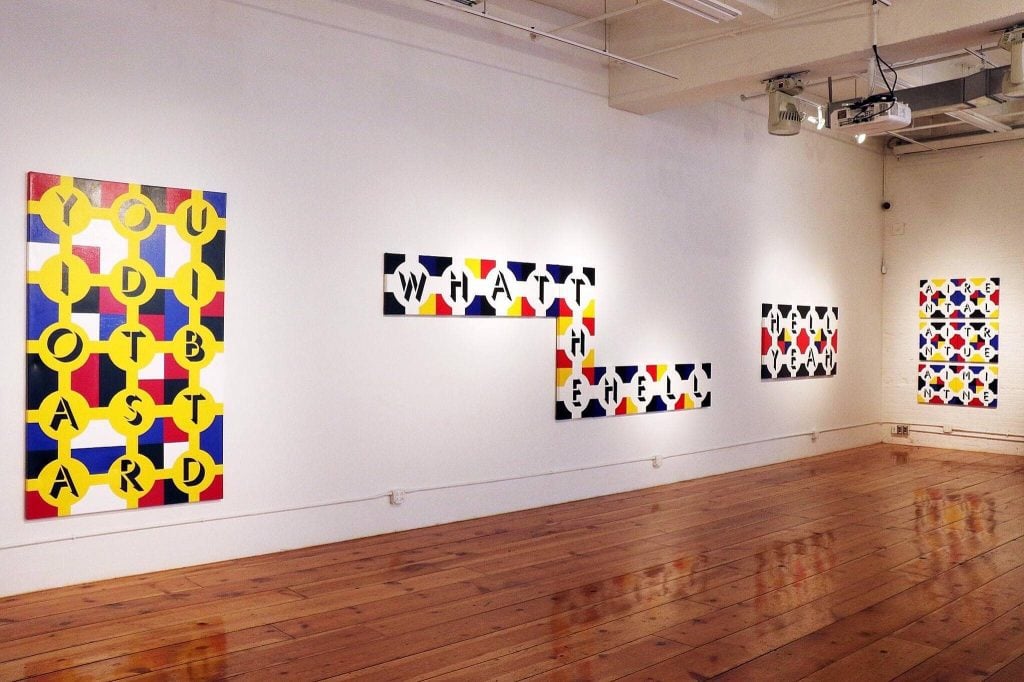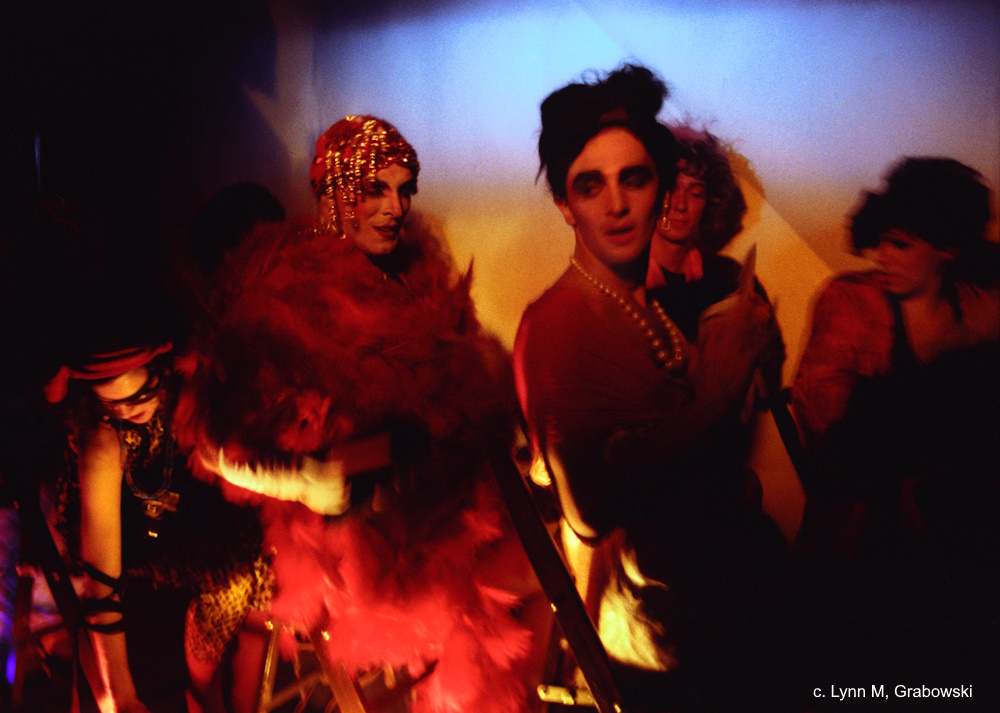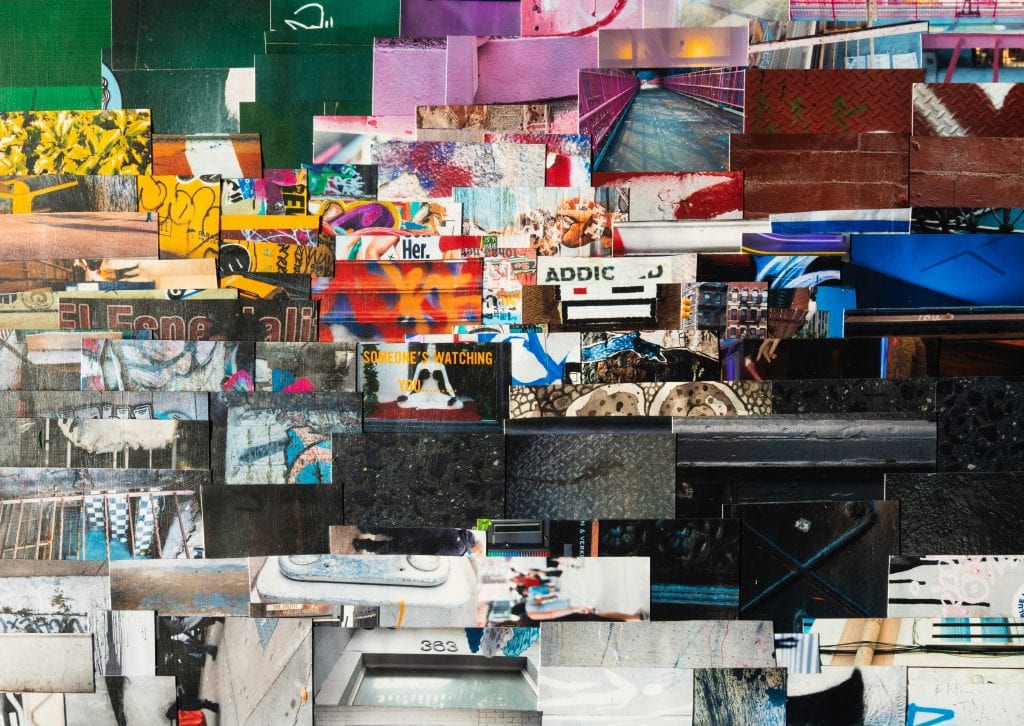Empire: An Arturo Vega Retrospective will open at the Bob Rauschenberg Gallery at FSW on November 4. The opening reception is from 6-8pm. On November 5 at 1pm, there will be a panel discussion with special guests Carlo McCormick, Legs McNeil, Anthony Haden-Guest and Adam Lehrer.
Join us in Florida, or online! Stay tuned in to the blog and Howl! Happening social media for updates from opening night and panel discussion.
#ArturoVegaEmpire

Introduction by Jade Dellinger, Director of the Bob Rauschenberg Gallery at FSW:
In 1992, as an NYU graduate student living on 3rd Avenue and 9th Street in the East Village, I was up and down the Bowery with great frequency. CB’s 313 Gallery presented an exhibition of Arturo Vega’s Insults, and, although the vitality of anything artistic around CBGB’s seemed to have long-since diminished, this particular visual art show resonated and enticed me back for repeat visits. At the time, I knew little if anything about the artist or his rather profound relationship to that historic place, but his paintings (as verbally abusive as they seemed) clearly spoke to me.
About five years later, I began assembling an archive and building a personal collection of punk era artifacts. I amassed boxes of Devo-related material while researching the book I co-authored about the band, but was feverishly tracking down significant memorabilia from others too. In July of 1999, Dee Dee, Tommy, Johnny, Joey, Marky and CJ Ramone made a special appearance at the Virgin Megastore on Union Square for the release of their Rhino Records’ Anthology. After years of random neighborhood sightings (primarily of Joey – who at 6-feet, 6-inches was always hard to miss), I had the opportunity to finally meet them all in a single unforgettable evening (along with tour manager Monte Melnick and crew). When the Ramones were welcomed into the Rock n’ Roll Hall of Fame a few years later, I lent a number of items – including the classic Arturo Vega-designed Ramones t-shirt that was once owned (a highly-prized possession) and stage-worn by the Sex Pistols’ late bassist Sid Vicious – for the display celebrating the band’s 2002 induction.
As art director for the Ramones and their longtime friend, Arturo Vega was the foremost authority, trusted spokesperson and gatekeeper for the band. He often interacted with fans managing their official website, so I corresponded with him occasionally in the decade that followed the Ramones’ retirement. I enthusiastically reached out once more in 2011 when I had the good fortune to acquire a 5 x 20-plus ft. hand-painted canvas banner that Arturo created in the 1970’s as the primary backdrop for the Ramones club dates. He expressed enthusiasm for my find and confirmed the authenticity and provenance of my acquisition. Arturo sent me the catalogue for his upcoming exhibition at Galería OMR in México, D.F. and wrote, “It’s very cool how you and I share interests in Art and the Ramones… I hope we can meet soon and talk and work on something together.”
So, the invitation from friends at Howl! Happening in New York this year to contribute an essay to a catalogue in conjunction with a (sadly now posthumous) solo show of Arturo’s Insults seemed both full-circle and an appropriate impetus to make good on finally doing something together even if simply collaborating in his absence with those who represent him so thoughtfully at the Arturo Vega Foundation. This first ever U.S. museum retrospective simply would not have been possible without the tireless efforts of Howl! Happenings/An Arturo Vega Project director Ted Riederer, and the vision, passion, unwavering commitment and support of Jane Friedman at the helm of the late artist’s Foundation. I am grateful to both for the opportunity and honored to present this important body of work at the Bob Rauschenberg Gallery at FSW.
Empire: An Arturo Vega Retrospective
By Jade Dellinger, Director of the Bob Rauschenberg Gallery at FSW
Alerting us to the cultural and economic affect both U.S. and Spanish colonialism had and was having on his Mexican homeland, the late artist Arturo Vega painted and screen-printed a monumental multi-panel canvas he called Empire in 1989. Superimposing photo-based imagery of an open hand offering or accepting American “silver dollars” over Honduran, Costa Rican, Panamanian, Filipino, Spanish and Mexican flags, Vega seems to acknowledge that U.S. trade and monetary policies were by then as dominant as the “empire on which the sun never set”. Spain had once ruled all of these represented nations and many more as the first global empire in history, imperialism and money were but two of the shared interests and themes regularly explored by both Arturo Vega and gallery namesake Bob Rauschenberg.
In 1961, with newly elected President John F. Kennedy strategically increasing the number of U.S. troops in Vietnam, Rauschenberg reacted to what he then perceived as imperialist aggression by installing his solo Leo Castelli Gallery show day-by-day, a single work at a time, over the month-plus duration. Attempting to provide subtle commentary while non-violently mimicking our militarism and expansion of war, the artist featured two new combines he titled Empire I and Empire II as the exhibition that preceded Rauschenberg’s was gradually replaced by these and other assemblages. Steadily extending his presence, commanding greater authority and asserting dominance over the previous (slowly disappearing) installation in Castelli’s exhibition space, Rauschenberg, a former U.S. Navy draftee who had been outspoken about his aspiration “not to kill” and antiwar beliefs, was amply aware of the tactics employed and human costs suffered when governments unjustly asserted their force.
Both artists, Vega and Rauschenberg, undoubtedly knew that economic aid could have negative consequences too, but each explicitly understood that placing a coin in hand was a more reasonable solution than offering insults or arms. As, just a year prior, in 1960, attempting to create a “mascot” for Jean Tinguely’s large kinetic and “self-destructive” Homage to New York in the sculpture garden of the Museum of Modern Art, Rauschenberg presented his Money Thrower for Tinguely’s H.T.N.Y.. A small sculpture with springs, once loaded, the work was built to propel a dozen or more silver dollars into the hands of an appreciative crowd and proved a playful alternative to the imposing presence of Tinguely’s more complicated and likely more dangerous apparatus.
Decades later, when Rauschenberg exhibited his work at the Museo Rufino Tamayo, the renowned Mexican poet Octavio Paz wrote, “A Wind Called Bob Rauschenberg,” in his honor. Art and ideas, like currents of air, are difficult to contain and can travel broadly like flung coins in unexpected directions. In the 1980’s while Vega was responding to similar global issues through his “Silver Dollar/Flags” series in New York, Bob Rauschenberg began a worldwide initiative (Rauschenberg Overseas Culture Interchange/ROCI) working with locals to present exhibitions in nations that were developing or simply difficult for Americans to access. Ultimately realizing eleven stops in countries like Cuba, Chile, Russia and China, Rauschenberg noted that, “Mexico was an ideal place to start because at that moment our political relationship had never been weaker.” Unfairly criticized by some in the United States as a “project of cultural invasion” or, worse, “American cultural imperialism”, Rauschenberg’s stated goal for ROCI was to “introduce the world to itself” and his committed efforts would in due course prove to have an overwhelmingly positive and lasting impact.
Having discovered Elvis as a child and later co-directing a touring production of The Who’s “Tommy” at the National University in Mexico City, Arturo Vega also understood the revolutionary and transformative power of music, theatre/performance and art. While working on his first painting series of supermarket signs, he befriended members of The Ramones, a rock & roll band that would soon play their first show (and would decades later be inducted into the Rock n’ Roll Hall of Fame). Designing the Ramones’ ubiquitous logo based on the Great Seal of the United States, painting backdrops for their stage and creating a lighting scheme loosely adapted from Albert Speer’s Lichtdom to enhance their effect, Vega created visual imagery that defined the transgressive aesthetic of punk rock by co-opting and questioning symbols of power.
Having narrowly escaped the repressive violence of an authoritarian regime under Mexico’s “perfect dictatorship” in the late ‘60s, Vega immigrated to the United States to pursue a career in the arts and enrolled in English, philosophy and photography classes at the New School for Social Research. Falsely labeled with fellow “drug-addicted Hippies” (by El Nacional newspaper report at the time), Vega had been arrested at a party in an affluent suburb of Mexico City and detained by police in a much-publicized incarceration of 148 of the country’s most notable artists, poets and intellectuals (including Chilean filmmaker Alejandro Jodorowsky). With government forces still carrying out disappearances (estimated at over a thousand), systematic torture, and extralegal executions during this so-called Dirty War, this harrowing incident signaled that it was now time for Vega to leave.
Famously speaking of working in the gap between art and life, Bob Rauschenberg often took to the streets for raw material and inspiration. “I want my paintings to look like what’s going on outside my window,” he once confessed, “rather than what’s inside my studio.” For Rauschenberg, “’If I walked completely around the block and didn’t find enough to work with, I could take another block…” He had purchased his five-story building at 381 Lafayette Street (near Great Jones) several years prior to Arturo Vega’s 1973 arrival in New York City. Yet, with Vega at his 6 East 2nd Street loft (and little more than a block and the Bowery separating the two for over three decades), it seems inevitable that their paths would have crossed.
Perhaps in part inspired by Rauschenberg, Arturo Vega would occasionally proclaim, “My ideas come from the streets.” As a child growing up in Estado Libre y Soberano de Chihuahua – the Free and Sovereign State or the Big State of Chihuahua, Arturo Vega was introduced to rock n’ roll as American radio infiltrated the Mexican airwaves. Vega and Rauschenberg understood that art had the power to permeate borders and bring revolutionary change. They were born and raised on opposite sides of the Tex-Mex divide, but were citizens of the world with global ambition to engage in a dialogue about the socio-political, humanitarian and monetary impact of nations. So, while Rauschenberg and Vega may never have been formally introduced, these artists clearly had much more in common than the close proximity of their live/work situations and a shared attraction to their neighborhood as a source for creativity.
“Empire: An Arturo Vega Retrospective” at the Bob Rauschenberg Gallery invites viewers to contemplate these parallels. Of course, as Rauschenberg once said and Vega would undoubtedly have concurred, “(Art was) a means to function thoroughly and passionately in a world that has a lot more to it than paint.”
++



